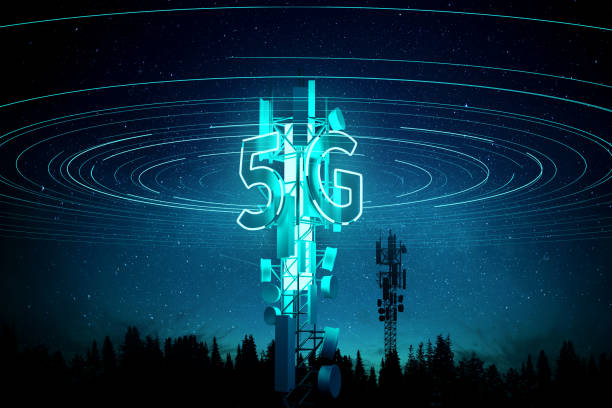
In today’s fast-paced digital world, 5G technology is not just a buzzword—it’s the backbone of future innovations. While 5G promises ultra-fast connectivity, low latency, and massive device support, another revolutionary force is amplifying its potential: Artificial Intelligence (AI). The fusion of AI and 5G is shaping a smarter, more connected world, unlocking opportunities across industries like healthcare, transportation, smart cities, and beyond.
In this article, we’ll dive deep into the transformative role of AI in 5G technology, how it enhances network performance, its applications, and what the future holds for this powerful synergy.
Understanding 5G Technology
Before exploring AI’s role, it’s crucial to understand what 5G is. 5G stands for the fifth generation of wireless technology. It’s designed to deliver:
- Faster Speeds: Up to 100 times faster than 4G
- Lower Latency: Near-instantaneous communication (as low as 1 millisecond)
- Massive Connectivity: Supporting millions of devices per square kilometer
These capabilities are essential for emerging technologies like autonomous vehicles, remote surgeries, smart homes, and the Internet of Things (IoT). However, managing such complex networks requires more than traditional infrastructure—this is where AI steps in.
The Role of Artificial Intelligence in 5G Technology
AI plays a pivotal role in optimizing, managing, and securing 5G networks. Its ability to process massive data volumes, identify patterns, and make real-time decisions makes it a perfect match for the dynamic demands of 5G. Here’s how AI transforms 5G technology:
1. Network Optimization
5G networks are complex, with multiple frequency bands, dense cell deployments, and varying user demands. Traditional manual network management can’t keep up with this complexity. AI helps by:
- Self-Optimizing Networks (SONs): AI enables networks to automatically adjust parameters for optimal performance without human intervention.
- Predictive Maintenance: AI algorithms predict potential network failures before they occur, minimizing downtime.
- Traffic Management: AI analyzes real-time data to manage network congestion, ensuring smooth connectivity even during peak usage.
2. Enhancing Network Security
With more devices connected than ever, 5G networks are vulnerable to cyber threats. AI strengthens security by:
- Threat Detection: AI algorithms detect unusual network patterns that may indicate cyberattacks.
- Automated Response: AI can trigger immediate responses to threats, such as isolating affected areas of the network to prevent widespread damage.
- Fraud Prevention: In industries like banking and e-commerce, AI helps detect fraudulent activities in real time.
3. Improved Quality of Service (QoS)
AI ensures users experience the best possible service by:
- Dynamic Resource Allocation: AI predicts where network resources are needed most and allocates them efficiently.
- Personalized User Experiences: By analyzing user behavior, AI can tailor services to individual needs, enhancing satisfaction.
4. Enabling Edge Computing
Edge computing brings data processing closer to the devices generating the data, reducing latency. AI enhances edge computing in 5G networks by:
- Real-Time Decision Making: AI processes data at the edge, enabling applications like autonomous vehicles and smart factories to operate with minimal delay.
- Energy Efficiency: AI optimizes power usage at the edge, extending battery life for IoT devices.
5. Supporting IoT Ecosystems
The IoT ecosystem relies heavily on 5G for seamless device communication. AI helps manage this ecosystem by:
- Device Management: AI automates the onboarding, monitoring, and maintenance of IoT devices.
- Data Analytics: AI analyzes data from IoT devices to derive actionable insights for industries like healthcare, agriculture, and manufacturing.
Real-World Applications of AI in 5G
The collaboration between AI and 5G is not just theoretical—it’s transforming industries worldwide. Here are some real-world applications:
1. Autonomous Vehicles
AI-powered 5G networks enable self-driving cars to communicate with each other, traffic lights, and road infrastructure in real time. This reduces accidents, improves traffic flow, and enhances passenger safety.
2. Smart Cities
AI and 5G create smart cities where traffic lights adjust based on real-time traffic data, waste management systems optimize collection routes, and energy grids efficiently distribute power.
3. Healthcare
In telemedicine, AI analyzes patient data, while 5G ensures seamless real-time consultations. AI also assists in robotic surgeries, where precision and low latency are critical.
4. Industrial Automation
Factories use AI-driven robots connected via 5G for tasks like quality control, predictive maintenance, and supply chain management, increasing efficiency and reducing costs.
The Future of AI and 5G
As 5G networks continue to evolve, the integration with AI will deepen. Here’s what the future holds:
- 6G Development: While 5G is still expanding, researchers are already exploring 6G, where AI will be embedded into the core network for even greater efficiency.
- Hyper-Personalization: AI will enable hyper-personalized experiences, from tailored entertainment content to customized healthcare plans.
- Advanced Automation: Expect more industries to adopt AI-driven automation, from agriculture with smart drones to finance with AI-powered trading algorithms.
Conclusion
The synergy between Artificial Intelligence and 5G technology is reshaping the world as we know it. AI enhances 5G by optimizing networks, improving security, enabling real-time decision-making, and supporting vast IoT ecosystems. Together, they are driving innovations across industries, making our lives smarter, safer, and more connected.
As we stand on the brink of this technological revolution, one thing is clear: the future belongs to those who embrace the power of AI and 5G.
Curious about what’s next? Stay tuned for our upcoming article where we explore “The Impact of 5G on the Internet of Things (IoT)” and discover how 5G is transforming the way devices communicate in our increasingly connected world.
For more insightful tech articles, visit www.techafri.com—your go-to platform for the latest in technology trends.

